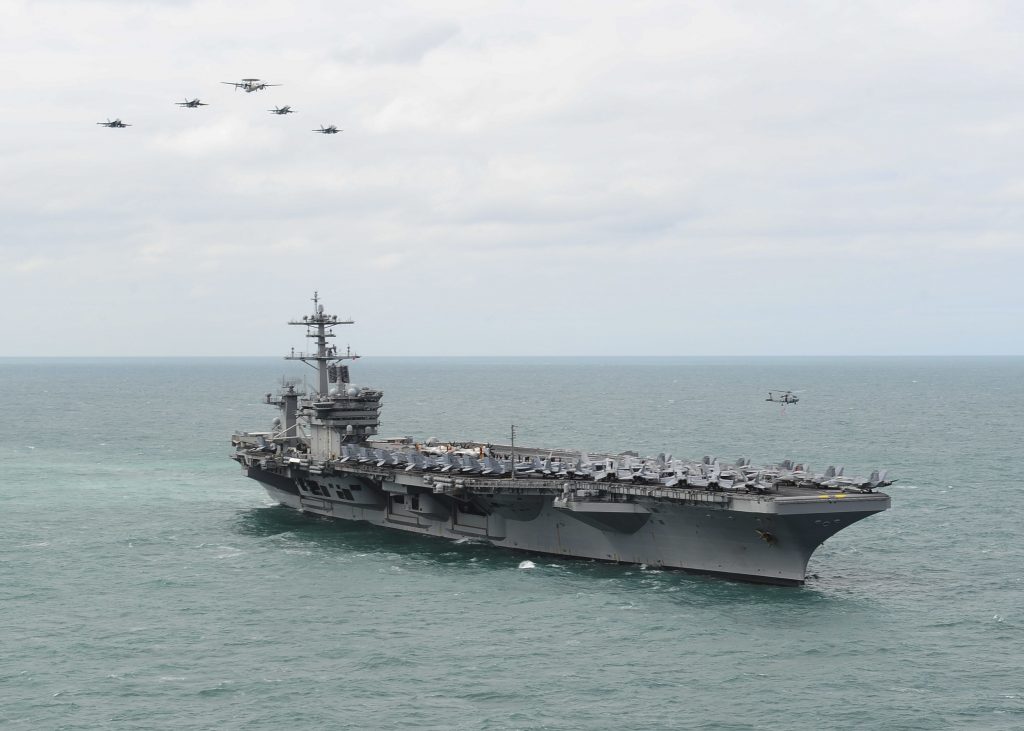
By Commodore Anil Jai Singh, IN ( Retd)
New Delhi. 10 April 2020. In less than a week after removing Captain Brett Crozier, the Commanding Officer of the 100,000 tonne US Navy aircraft carrier, the USS Theodore Roosevelt from command, the Acting Secretary of the Navy (NAVSEC) Thomas Modly resigned from his post on 07 April 2020. The sequence of events between these two occurrences represents an unseemly saga of political arrogance, questionable senior leadership and interpretation of ‘chain of command’ and led to this situation which, with some maturity could have been handled much better. This incident gives rise to three fundamental questions from the principal cast of characters
(a) Captain Brett Crozier – was he justified in sending the email highlighting his concerns ?
(b) The ‘Chain of Command’ – Was it providing the Captain the desired support and reassurance ?
(c) Acting Secretary of the Navy (NAVSEC) Thomas Modly – Was he justified in the haste he showed in removing Captain Crozier from command ?
Captain Brett Crozier
The storm erupted on 31 March 2020 when Captain Brett Crozier, the Commanding Officer of the USS Theodore Roosevelt wrote a four page letter and sent it by e-mail to ’20-30 people’ and which also got leaked to the San Francisco Chronicle. He highlighted the rapid spread of the Corona virus amongst the crew on his ship who live in cramped mess decks and work in confined spaces on board. He requested that the ship be evacuated in Guam because the US was not at war and there was no reason therefore for people to die unnecessarily if it could be avoided. He also clearly stated that this will perhaps require a political decision. He did not instigate a mutiny, he did not hazard his ship, he did not disobey any orders and he continued doing what he was tasked to do but was removed from command without even a preliminary inquiry.
On 09 March, the Roosevelt sailed from Da Nang in Vietnam after a five day visit. On 24 March it reported that three crew members had tested positive. Within a few days, many more were infected and the number was increasing. This was known to all and was also being covered in the media. The NAVSEC stated that on 26 March, his Chief of Staff had spoken to the Captain and so it wasn’t that they were unaware of the problem. The ship came alongside at Guam on 27 March.
Even though the entire organisation and the chain of command ashore were aware of the problem, they obviously did not do enough to appreciate the CO’s concerns or address them to his satisfaction. As the man on the spot the CO’s inputs should have received far more traction than they probably did. The fact is that he felt concerned for his crew because he understood the potential fallout of the pandemic spreading on board which his superiors perhaps failed to appreciate. The CO showed the loyalty expected of him to his crew and their well-being ahead of his personal concerns about the consequences.
It should not be forgotten that Captain Crozier has more than 28 years of naval experience under his belt and besides spending plenty of time on board aircraft carriers as an aviator, he has also been the XO of another super carrier, the USS Ronald Reagan and thereafter commanded the USS Blue Ridge so his credentials for command of a ship like the Roosevelt were impeccable. Hence to blame him for his ‘foolish lapse of judgement’ may require deeper investigation.
Chain of Command.
Captain Crozier is accused of bypassing the chain of command and not keeping it in the loop. The CO’s immediate superior is the Carrier Strike Group (CSG) Commander who was also embarked on the same ship. The CSG Commander in this case, Rear Admiral (1-star) Stuart Baker, also a highly experienced aviator with extensive carrier flying experience has never been either an XO or CO of any afloat platform throughout his career. However, without passing judgement on whether this inexperience may have affected his appreciation of the situation on board, he was the person responsible for the entire CSG. Therefore, seeing the situation developing on his flagship, he should have been equally concerned, if not more than the CO and should in fact have been highlighting the CO’s anxieties to his superiors right up to the Commander-in-Chief of the Pacific Fleet under whose command the ship would have been operating. This perhaps was not happening which prompted the CO to address his mail higher up the chain.
There is no reason to doubt that the authorities ashore would have been taking action to address the issue but the leadership in the ‘chain of command’ obviously failed to communicate that to the ship and its CO. While the chain of command must be respected and surely Captain Crozier understands this and must have adhered to it faithfully for 28 years to have reached the pinnacle of command at sea, the chain of command has a duty to the man at sea. It should be conscious of its own responsibility to make the right decisions. In this case, even after the CO was removed from command, which to a crew can be devastating, not one person in that ‘chain of command’ from a 1-star Admiral to a 4-star Admiral felt the need to address and reassure the crew. It was finally left to the NAVSEC to do so, and what a mess he made of it. Infact, most surprisingly, the CSG Commander who should have been the first to address and reassure the men and women not only of his Flagship but of all 8 ships under his command conspicuously failed to do so.
Acting NAVSEC Thomas Modly
The conduct of Acting Navy Secretary Thomas Modly was, in one word, unacceptable. Its obvious that his seven years in the US Navy, also as an aviator taught him little about the military and its ethos and he let the arrogance of a politician in power get the better of his good judgement. The haste with which he ordered the removal of the CO without even an enquiry into the incident leads one to believe that he was looking for a scapegoat to cover up for the establishment’s poor response. Whatever little grace he expressed even while dismissing the Captain disappeared when he visited the ship and spoke ill of the Captain calling him ‘stupid’ and ‘naïve’ while addressing the crew. He had obviously been irked by the fond farewell the Captain got from his crew and it showed in his immature rant which was most unbecoming of an ex-Naval officer. It was only after the criticism he received from all quarters which even prompted the President Trump to wade into the issue that he ‘offered’ his resignation.
As is if that was not bad enough, by the time Modly ordered an enquiry into the incident to be conducted incidentally by his own subordinate, the VCNO, he had already removed Captain Crozier from command. Hence the direction in which the enquiry was going to proceed was also pre-determined.
The Aftermath
Presently the ship is docked in Guam; it will be alongside for at least a fortnight or even longer. More than 50% of the crew has been tested and over 2000 have been quarantined ashore. This is exactly what the CO had requested in the first place. Almost 250 personnel have been tested positive which is exactly what the CO had feared. This number is bad enough by itself but had the crew been on board, it would have been far worse.
Conclusion
This incident has focussed attention on some important issues. Captain Crozier has upheld the highest traditions of command by placing his loyalty to the crew and their lives ahead of allegiance to his seniors for personal advancement (command of the Roosevelt is almost an assurance of Flag rank to follow) which is more than can be said of the others in this cast of characters. The conduct of the ‘chain of command’ would have seriously undermined the confidence of commanders at sea and in the field. While politicians will be politicians and therefore in most cases not much can be expected of them by way of remorse, the senior military brass of the US Armed Forces and particularly the ‘chain of command’ in this case starting from the Commander CSG Roosevelt Group upwards needs to do some serious soul searching about their sacred duty to do right by their commanders in the field and not throw them to the wolves. The Pentagon must assuage these concerns by initiating a fair and impartial inquiry and apportion accountability and blame for the acts of commission and omission if they are to regain the trust of the men and women they send into harm’s way.
(Commodore Anil Jai Singh is a former submariner. He did five afloat command tenures including four submarine commands and a Fleet ship command. He is the Vice President of the Indian Maritime Foundation and can be reached at ajaisisingh59@gmail.com, and @AJS_subdriver)































































































































